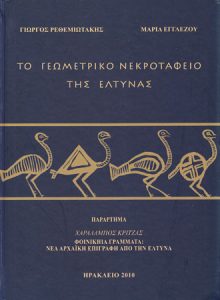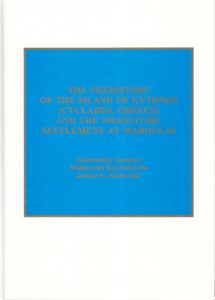ARTICLES | 2010
Argos: L’Aspis
Bulletin de Correspondance Hellénique 134 Rapports (2010): 551-566.
Dans le cadre du Programme d'étude topographique et architecturale de l'Aspis, cofinancé depuis 2005 par l'EFA et l'INSTAP, la campagne de 2009 a comporté, d'une part, des opérations de terrain, d'autre part, des travaux d'étude.Etude des coutumes funéraires en Crète néopalatiale
Bulletin de Correspondance Hellénique 134 (2010): 31-70.
The poverty of the Neopalatial funerary record (1650/1640-1440/1430 B.C.) is the subject of this paper, for which both natural and cultural factors are explored. The exposition of corpses to the elements or their crude deposition in natural cavities seems to be the reason for their rarity in the Neopalatial archaeological landscape. It can also be related to ancient Cretan practices.À propos des obsidiennes du palais de Malia
Bulletin de Correspondance Hellénique 134 (2010): 1-29.
This article treats the obsidians found during recent excavations of the pre- and proto-palatial levels within the palace of Malia or in the immediate proximity. The material has been examined from different angles, beginning with the knapping technique.The role of Cyprus and the Mycenaean / Greek presence in the island from the End of Bronze Age to the first Phases of Iron Age
Studi Micenei ed Egeo-Anatolici 52 (2010): 149-167.
In the period following the fall of Mycenaean palaces, of the Hittite empire and the small states in Syro-Palestinian areas a likely new role for Cyprus seems to open. The island not only maintains its peculiar position as key point for trade but also becomes the cross-road for people who stop in Cyprus, often only provisioning, moving from and towards other countries.Το Γεωμετρικό Νεκροταφείο της Έλτυνας
Heraklion

ΑΛΣ (ΑLS). Periodical edition of the Society for the Promotion of Studies on Prehistoric Thera (Nr. 7)
Athens

Νέα δεδομένα από τις πρόσφατες αρχαιολογικές ανασκαφές της Λήμνου
Annuario della Scuola Archeologica di Atene e delle Missioni Italiane in Oriente LXXXVIII (2010):311-346.
Η ιστορική μοίρα της Λήμνου, από την αχλύ της προϊστορίας ως τις μέρες μας είναι στενά συνυφασμένη αφενός με την καίρια γεωστρατηγική της θέση στην είσοδο σχεδόν των Δαρδανελλίων και αφετέρου με τη γεωμορφολογία της που πρόσφερε ασφαλείς όρμους και άφθονη, εύφορη καλλιεργήσιμη γη. Την πρώτη μεγάλη άνθηση της γνώρισε η Λήμνος ως γνωστόν, κατά την Πρώιμη Εποχή του Χαλκού με παραπάνω από 20 εντοπισμένους ως σήμερα οικισμούς.Climate change and the demise of Minoan civilization
Climate of the Past 6 (2010): 525-530.
Climate change has been implicated in the success and downfall of several ancient civilizations. Here we present a synthesis of historical, climatic, and geological evidence that supports the hypothesis that climate change may have been responsible for the slow demise of Minoan civilization.The Prehistory of the Island of Kythnos (Cyclades, Greece) and the Mesolithic settlement at Maroulas
Krakow

New Light on the Bronze Age Ceramics from H. Schliemann’s Excavations at Troy: Studies on the Munich and Poznań Collections within the Anatolian-Aegean Cultural Context
Oxford

Ancient Crete. From Successful Collapse to Democracy’s Alternatives, Twelfth to Fifth Centuries BC
Cambridge

Analysing Pottery. Processing – Classification – Publication.
Bratislava

From Minos to Midas: Ancient Cloth Production in the Aegean and in Anatolia
Oxford

The Early and Middle Pleistocene Archaeological Record of Greece: Current Status and Future Prospects
Leiden

